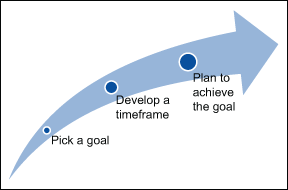
The Harada method helps individuals achieve self-reliance that in turn facilitates a company’s process improvement journey. This week’s article provides an overview of the method and its genesis. Part Two of this article presents five templates to use to plan a goal, measure the goal’s progress and assess success.
No matter its size, an organization is driven by its objectives, mission and values; these factors are in large part realized by the employees in the organization. To achieve its desired results and excel in its business, organizations need their employees to perform at their peaks.
Lean: Eight Types of Waste
One of the ways organizations help maximize their value is by using Lean and getting rid of waste. There are eight types of wastes that can improve profitability and create more satisfied customers. They are:
- Transport: Unnecessary movement of people, equipment, products and information
- Inventory: Excess storage of parts, documentation and materials – ahead of requirements
- Motion: Unnecessary movement by the people working on the job (e.g., bending, lifting, etc.)
- Waiting: Waiting for instructions, information, equipment and parts in a production line
- Over-production: Making more than what is needed at a point in time
- Over-processing: More work than is required for the job
- Defects: Waste due to rework, scraps and incorrect documentation
- Skills/talent: Underutilized skills, knowledge and talent of people, inadequate training for delegated tasks
The first seven wastes are wastes in the manufacturing process itself. There are tools and methodologies like Kaizen, Six Sigma, 5S, cellular manufacturing and more that help eliminate or reduce such wastes. That leaves the eighth waste, which deals directly with the people involved in the process; better utilizing and handling employees reduces this waste. The Harada method helps eliminate the waste of skills and talent.
Focus on People
Organizations tend to focus more on processes than the people working on the processes. Employees working in and with a process can become like robots – with no minds of their own. They stop feeling ownership of the process; this leads to boredom and stagnation. They stop thinking about improving the process. Processes become so rigid that a small change seems too big and improvements are not achieved until the process becomes obsolete.
By implementing small process changes, businesses can make changes in the way in which the work is completed. If employees are more involved in the processes they work on they “own” the processes and take pride in their work. Thus, thee processes better as people hone their skills.
Monozukuri and Hitozukuri
Monozukuri does not have a direct translation from Japanese to English, but essentially means “craftsmanship.” Basically, it is the art or process of creating the best products – not just through technology, but by taking pride in work and achieving excellence in manufacturing processes and through continuous improvement.
Hitozukuri = hito + zukuri or people + process of making. Effectively, hitozukuri stands for the process of educating and forming people. The pride and the excellence in craftsmanship by continuous process improvement can be achieved using hitozukuri, and monozukuri can be achieved by hitozukuri.
But hitozukuri stands for much more than just educating people. It is a continuous process that enables people to mature along with their art (or work) to achieve success in their fields and skills. By using hitozukuri, employees are not only guided along their work and their tasks, but are enabled such that they can set their own targets and then improve their own work to meet those targets.
Hitozukuri is a way in which people within as well as outside the organization, train and mentor the employees to:
- Learn new skills,
- Master current jobs and mentor others,
- Rotate jobs and grow within the organization to achieve new and higher positions,
- Develop self-confidence and self-belief that enables the employee to do better, and
- Find new ways to improve existing processes.
Hitozukuri focuses on using the talent that is within the organization and treating it with respect.
Takashi Harada and the Creation of the Harada Method
Takashi Harada, a Japanese high school teacher, developed what is now known as the Harada method, which provides a process for hitozukuri. The Harada method deals with the human side of Lean and enables employees to be successful by identifying and embracing a goal or task that helps them move forward.
In Osaka, Japan, Harada taught track and field in a an overall low-rated junior high school. As a coach, he observed that students outside his school were outperforming his athletes. No amount of coaxing made his runners perform better. Harada knew it was time for a change in the mindset of his students. He studied the ways in which successful teams, coaches and leaders worked. From these studies, he came up with an approach that helped his students achieve greater success.
The Harada method was designed with the view of teaching each student (or employee) to be a great leader and also a coach – able to build a winning team. This method falls in line with Lean Six Sigma and other methods and tools that drive continuous improvement.
Self-reliance: The Essence of the Harada Method
The essence of the Harada method is self-reliance – the confidence and the ability of individuals to develop their skills to the extent that they are virtually irreplaceable. This self-confidence enables them to use their skills for their own improvement as well as that of the organization. Such employees can be trusted to make correct, well-informed decisions. As the goals are set by the employees themselves, there is no ambiguity or question of ownership of these goals.
The Harada method encourages improvement across all levels of an organization, including the following:
- It makes leaders and coaches out of managers.
- Not only does it improve a person’s skill level, but it also creates a vision for the long-term personal success of the individual.
- Once individuals visualize what they want to achieve, this method teaches them how to set smaller goals on the road to realizing their greater vision.
- As individuals work toward achieving success, individuals’ self-esteem is raised and further pushes them to do better. This also improves their confidence.
- Once the path for moving forward is defined, it is easier to repeat success.
- Any individual is able to be successful.
A Focus on Self-reliance
The Harada method’s focus is self-reliance – individuals should improve themselves so much that success follows on its own. This can be achieved by improving an individual’s spirit, skills, physical conditions and daily life. Success cannot be achieved, however, unless an individual makes the effort to attain it. The individuals must master the skill they are working on, whether that skill is data entry or complicated machinery work. Once the skill is mastered, the individual can better the skill and ensure that it is performed consistently.
The ability to bring passion to work is a critical component along the path to self-reliance. The most boring and routine of tasks can be interesting if the person performing those tasks has passion. Passion enables individuals to look for ways to improve their tasks and help remove boring aspects of their work. Consider, for example, the goal of running 10 miles every day. Although that 10 mile run may not be interesting, the goal is defined. By then applying the Harada method there are interim targets that can be set to help achieve that goal and make the journey more interesting.
The Harada method leads an individual through five stages:
- Premeditation: Choosing a skill that the person wants to excel at
- Personal excellence: Excelling at the chosen skill
- Goal setting: Setting goals to reach excellence
- Selfless service: Giving the tasks their all
- Self-reliance: Doing it yourself and relying on yourself for the success you want to achieve
The Steps to Self-reliance
The Harada method defines three high-level steps that teach self-reliance:
- Pick a goal,
- Develop a timeframe and
- Plan to achieve the goal.

In order to achieve their goals, there are some guidelines individuals should follow:
- Individuals should pick goals that are aligned with their personal visions and their companies’ visions. This is the most difficult step as picking a goal means committing to that goal and there is a risk of failure involved. In order to help facilitate success, be sure that the goal is in line with the company’s plans and it will be easier to gain the support of your superiors and colleagues.
- Develop a timeline for achieving the goal. It is important to define a realistic timeline – if the timeline is too ambitious or relaxed, the task of setting the goal itself will fail.
- Create the necessary measures to monitor progress. Without monitoring, individuals will never know if they are successful. For example, if the goal is to complete packing 10 items in two hours, then check in at the end of the first hour to see if the task is halfway complete.
Part 2 of this article presents five templates to use to plan a goal, measure the goal’s progress and assess success.